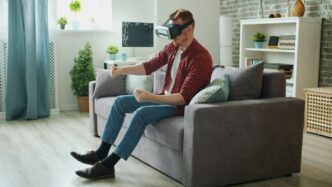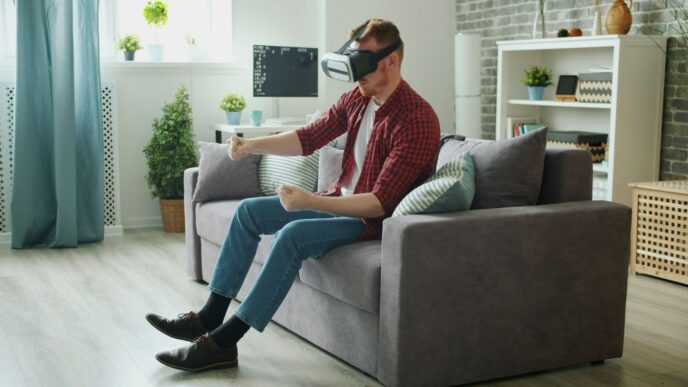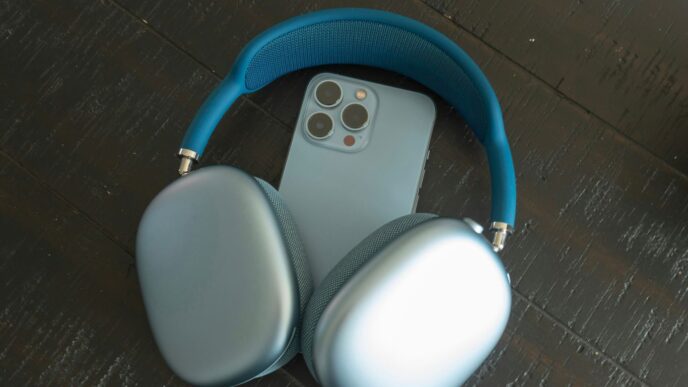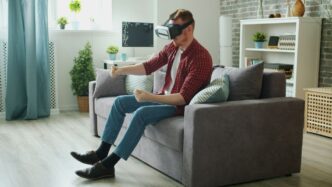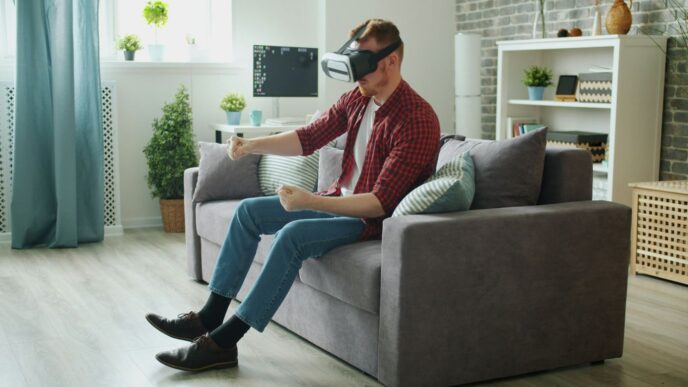Augmented reality (AR) isn’t just for sci-fi movies anymore. It’s become super accessible, letting us blend digital stuff with the real world right from our phones. Think fun filters on social media or seeing how furniture looks in your room before you buy it. The best part? You don’t need to spend a fortune to get started. There are a bunch of free augmented reality apps and tools out there that let you play around with this cool tech, whether you’re just curious or want to build something yourself. We’ve rounded up some of the top free augmented reality apps that make creating and experiencing AR easier than ever.
Key Takeaways
- You can create your own AR experiences without needing to code using tools like Spark AR Studio and Lens Studio.
- Adobe Aero is great for designers who want to bring digital art into the real world easily.
- WebAR platforms like 8thWall let you build AR experiences that work right in a web browser, no app downloads needed.
- Google ARCore and Apple ARKit are powerful developer tools for building AR apps on Android and iOS, respectively.
- Many free augmented reality apps and tools are available for learning, experimenting, and creating projects without initial costs.
Spark AR Studio
When you think about creating those cool filters you see on Instagram and Facebook, there’s a good chance Spark AR Studio was involved. This is Meta’s own platform, and it’s pretty popular for making augmented reality effects. What’s nice is that you don’t really need to be a coding wizard to get started. It’s got a visual interface, and you can drag and drop a lot of the elements, which makes it way more approachable for folks who are just dipping their toes into AR creation.
Even though it’s beginner-friendly, it’s not just for simple stuff. If you know your way around scripting, you can build some pretty complex and interactive AR experiences. Think face tracking, gesture detection, and even physics-based animations. Plus, you can test things out in real-time right on your computer before you push them out to the apps. They also have a bunch of free learning materials available, which is a big help when you’re starting out.
Spark AR Studio is a fantastic entry point for anyone wanting to experiment with AR filters for social media. It’s accessible enough for hobbyists and students, but also has the depth for more experienced creators to build unique effects.
Lens Studio

Lens Studio is Snap Inc.’s free software for building augmented reality experiences, specifically for the Snapchat platform. It’s a pretty robust tool that lets you create everything from simple face filters to more complex world lenses that interact with your surroundings. You don’t need to be a coding wizard to get started, as it offers a visual interface and plenty of pre-built assets. However, if you do have some JavaScript knowledge, you can really push the boundaries with advanced scripting. It’s a great way to get your AR creations in front of millions of Snapchat users. They also provide analytics so you can see how your lenses are performing, which is pretty neat if you’re trying to get a lot of people to use your creations. It’s definitely a go-to for anyone serious about making AR content for Snapchat, and you can find a lot of helpful resources on the Lens Studio website.
Adobe Aero
Adobe Aero is a pretty neat tool if you’re looking to build augmented reality scenes without needing to know how to code. It’s made by Adobe, so it plays nicely with other Adobe products like Photoshop and Illustrator, which is a big plus if you’re already in that ecosystem. You can import your 3D models and then arrange them in a space, adding some interactivity and animations to make things happen. It’s really aimed at designers, artists, and even educators who want to create AR experiences for things like marketing or just to show off an idea.
It’s pretty straightforward to get started:
- Import your 3D assets (like models you’ve made in other programs).
- Arrange these assets in a virtual space.
- Add simple interactions or animations to make your scene come alive.
- Share your AR creation with others to view on their devices.
While it’s not for building super complex, game-like AR, it’s a really accessible way to bring digital content into the real world visually.
8thWall
If you’re looking to build augmented reality experiences that work right in a web browser, 8thWall is a solid choice. The cool thing about this platform is that users don’t need to download any special apps to see your AR creations. They just need a web browser and their phone’s camera.
While 8th Wall has paid plans for bigger projects, they do offer a free tier. This is great for trying things out or for non-commercial stuff. You can do things like:
- Detect surfaces in the real world to place virtual objects.
- Make your AR look more realistic with lighting and reflections.
- Use images or even faces as triggers for AR effects.
It’s particularly good for businesses wanting to create interactive marketing campaigns or branded AR experiences that are easily accessible to a wide audience. Since it’s browser-based, it makes sharing and experiencing AR super simple.
Unity MARS
Unity MARS, which stands for Mixed and Augmented Reality Studio, is a pretty serious tool if you’re looking to build AR experiences that really understand and react to the real world. It’s built on top of the Unity game engine, so if you’re already familiar with Unity, this will feel like a natural extension. What’s cool about MARS is its focus on context-aware AR. This means it can use AI to help place your digital content in the right spot based on what it sees in the environment, like recognizing surfaces or specific objects.
It’s not exactly a point-and-click kind of app for beginners, but if you’re a developer or have some technical background, it’s quite powerful. You can create AR content that behaves intelligently, adapting to different real-world conditions. Think about AR apps that can overlay instructions directly onto machinery or place virtual furniture that looks like it’s actually in your room, respecting the space.
While the full version does require a subscription, Unity does offer a 45-day free trial, which is plenty of time to see if it’s the right fit for your project. Plus, students and educators can get access for free, which is a nice perk if that applies to you. It’s definitely geared towards creating more sophisticated AR applications rather than simple filters.
Google ARCore
Google ARCore is a solid choice if you’re looking to build augmented reality apps specifically for Android devices. It’s Google’s answer to Apple’s ARKit, and it really taps into the vast number of Android phones out there. You can create some pretty engaging AR experiences using its features like motion tracking, understanding the environment around you, and even estimating the light in a scene. This helps make the virtual objects feel more like they’re actually in the room.
One of the really neat things ARCore offers is its Cloud Anchors API. This lets you create shared AR experiences, meaning multiple people on different devices can see and interact with the same AR content at the same time. It integrates nicely with the Android SDK, and you can use it with Java/OpenGL or through Unity plugins, which is pretty convenient.
ARCore is completely free for developers to use. It’s a powerful platform for bringing AR to life on Android, and you can get started building your own apps without any upfront costs. It’s a great way to get into AR development, especially if your target audience is primarily Android users. You can configure your app to be either AR Required or AR Optional, which gives you flexibility in how you utilize AR capabilities.
Apple ARKit
When you’re looking to build augmented reality experiences specifically for Apple devices, ARKit is the go-to toolkit. It’s Apple’s own framework, meaning it’s deeply integrated with iPhones and iPads, and it’s completely free for developers to use. Think of it as the engine that powers a lot of the cool AR stuff you see on your phone.
ARKit lets you do some pretty neat things. It can track faces and bodies, which is how those fun filters work. It also understands the space around you, figuring out surfaces like tables and floors. This allows virtual objects to sit realistically in your environment. You can even have multiple people share the same AR experience at once, which is pretty wild when you think about it. For anyone building AR apps for the Apple ecosystem, this is a must-know. It’s what makes apps like MeasureKit possible, turning your device into a precise measurement tool.
Some of the key features include:
- Motion tracking: Keeps track of your device’s position and orientation.
- Environmental understanding: Detects surfaces and features in the real world.
- Light estimation: Adjusts virtual objects to match the real-world lighting.
- People occlusion: Makes virtual objects appear behind real people.
It’s pretty powerful stuff, and since it’s free, it’s a fantastic starting point for anyone interested in creating their own AR applications for iOS devices.
WebXR
WebXR is a pretty neat way to bring augmented and virtual reality experiences right into your web browser. You don’t need special apps or downloads for a lot of this stuff, which is a big deal. It means more people can jump in and try out these cool immersive worlds without a lot of hassle. Think of it as making AR and VR more accessible, like how websites became common for everyone.
The real power of WebXR is that it works across different devices and platforms. Whether you’re on a phone, a desktop, or a VR headset, the goal is for the experience to just work. This is a huge step forward because it means creators don’t have to build separate versions of their AR or VR content for every single device out there. It simplifies things a lot for developers and makes it easier for us to access these experiences.
Creating these experiences often involves using frameworks that help build 3D environments for the web. For instance, A-Frame is a popular choice that makes it much simpler to get started. It provides ready-made components, so you’re not starting from scratch. You can build interactive scenes, add 3D models, and even create simple games, all within the browser. It’s a good way to experiment with AR and VR without needing to be a coding wizard. The technology is still growing, but it’s already opening up some really interesting possibilities for how we interact with digital content.
Overlyapp
Overlyapp is a pretty neat tool if you’re looking to create your own augmented reality stuff without needing to know how to code. You can upload your own designs, videos, or even 3D models, and then just put them out there as AR projects. It’s kind of a quick way to add some interactive AR elements to things. They say it’s good for businesses, like showing off products in e-commerce or making building plans easier to understand for city planning. They also mention it can be used for education, like making interactive books, or even for art projects where you add digital layers to physical pieces.
They’ve been around since 2010, so they’ve seen the AR world grow quite a bit. It’s interesting how they talk about how AR is still pretty new, even though it feels like it’s everywhere now. They think in about ten years, we’ll probably be using AR glasses more, but for now, phones are doing a lot of the heavy lifting. It’s cool that they’re looking at different ways AR can be used, from helping NASA build spacecraft to making it easier for doctors to find veins. The market is definitely growing, which is something to keep in mind if you’re thinking about getting into this.
Polycam & Scaniverse
So, you’ve got these apps, Polycam and Scaniverse, and they’re pretty neat if you’re into making 3D models from the real world. Think of it like taking a bunch of photos of something, and then the app stitches them all together to create a 3D version. It’s called photogrammetry, and these apps make it surprisingly easy to do right from your phone.
Polycam is really good for capturing spaces and objects with a lot of detail. You can scan rooms, furniture, even people, and get a pretty accurate 3D model. It’s useful if you’re in architecture, real estate, or just want to digitize something cool. Scaniverse is similar, also great for scanning objects and environments. Both apps let you export your creations in different file formats, which is handy if you want to use the models in other software or for 3D printing.
Here’s a quick rundown of what you can do:
- Scan rooms to create floor plans or virtual tours.
- Capture objects for 3D printing or digital art projects.
- Digitize real-world items to use in AR experiences.
- Measure distances and areas within your scans.
It’s not perfect, of course. Sometimes you need good lighting and a steady hand to get the best results. But for free apps, they really let you play around with creating 3D content without needing fancy equipment. It’s a fun way to see the world in a new dimension.
Sayduck
Sayduck is a platform that helps businesses show off their products using augmented reality. Think about buying furniture online; instead of just looking at flat pictures, you can use your phone to see how that couch would actually look in your living room. It’s pretty neat for companies that sell things you need to visualize, like home decor or big items. They make it fairly simple to get started, so you don’t need to be a tech wizard to use it. This makes online shopping feel a lot more real. If you’re running an e-commerce store, especially on platforms like BigCommerce, Sayduck can help make your product pages more engaging by letting customers interact with 3D models of your items. It’s a good way to give people a better sense of what they’re buying before they click that checkout button. You can check out their BigCommerce integration for more details on how it works.
San
San is a bit of a different kind of app in the AR space. It’s not really about trying on clothes or placing furniture, but more about experiencing art in a new way. The creator, Gints Gabrāns, uses it to put digital art right into real-world places, like cities. What’s cool is that these artworks don’t have to follow normal rules of size or gravity, which is pretty neat. You can walk around and see these digital sculptures or paintings that just float or are way bigger than they should be. Sometimes, the artist even sells virtual land within the app, which is an interesting idea for digital ownership.
It’s a good example of how AR can be used for:
- Art installations: Imagine seeing a giant, colorful digital creature sitting on top of your local library. San makes that possible.
- Creative expression: Artists can make things that would be impossible in the real world, playing with scale and physics.
- Community engagement: Public art can be made more interactive and surprising.
It’s definitely a more niche app, focused on artistic and imaginative uses of augmented reality.
Fibbl
Fibbl is a platform that helps fashion brands put their products into augmented reality for online shoppers. Think of it like a virtual fitting room, but for your phone. It’s designed to make online shopping feel more real, so you know what you’re getting before you buy it. This can be a big help for brands because it means fewer people send things back after they arrive. Fibbl works with pretty much any phone or device, and the company says the visuals are really good, almost like being in a store. It’s a pretty neat way to bridge the gap between online browsing and actual shopping.
Wrapping Up Your AR Adventure
So, there you have it. Augmented reality isn’t some far-off future thing anymore; it’s here, and thanks to these free tools, it’s more accessible than ever. Whether you’re looking to spice up your social media with cool filters, create interactive art, or even just visualize furniture in your living room, there’s something out there for you. Don’t be afraid to jump in and start playing around with these apps. You might be surprised at what you can create with just your phone and a little imagination. The world of AR is vast, and these free options are a fantastic starting point for anyone curious to explore it.
Frequently Asked Questions
What exactly is augmented reality (AR)?
Augmented reality, or AR, is like adding a digital layer to the real world you see through your phone or special glasses. Imagine playing a game where characters pop out of your living room, or trying on virtual clothes before you buy them. It mixes the digital with what’s actually around you.
Why should I use free AR tools instead of paid ones?
Using free AR tools is awesome because you don’t have to spend any money to get started. They’re perfect for trying out new ideas, making cool projects for fun, or learning how AR works without needing to be a coding expert.
Do I need to know how to code to use these AR apps?
Many of these tools are made for beginners and don’t need any coding knowledge. They often have easy-to-follow guides and templates. You can start by playing with simple filters or adding virtual objects to your room.
Can I create my own social media filters with these apps?
Yes, absolutely! Many apps like Spark AR and Lens Studio are famous for letting you create your own filters for social media. You can make funny faces, add virtual hats, or even change the background of your videos.
How can these AR apps be used for learning or education?
Some tools, like Adobe Aero and Unity MARS, are great for making educational content. You can create 3D models of planets that float in your classroom or bring historical figures to life right in front of you.
Can I use these AR apps for shopping or trying out products?
Definitely! Apps like Overlyapp and Fibbl let you see how furniture or clothes would look in your own space before you buy them. This helps you make better choices and reduces the chance of returning items.





